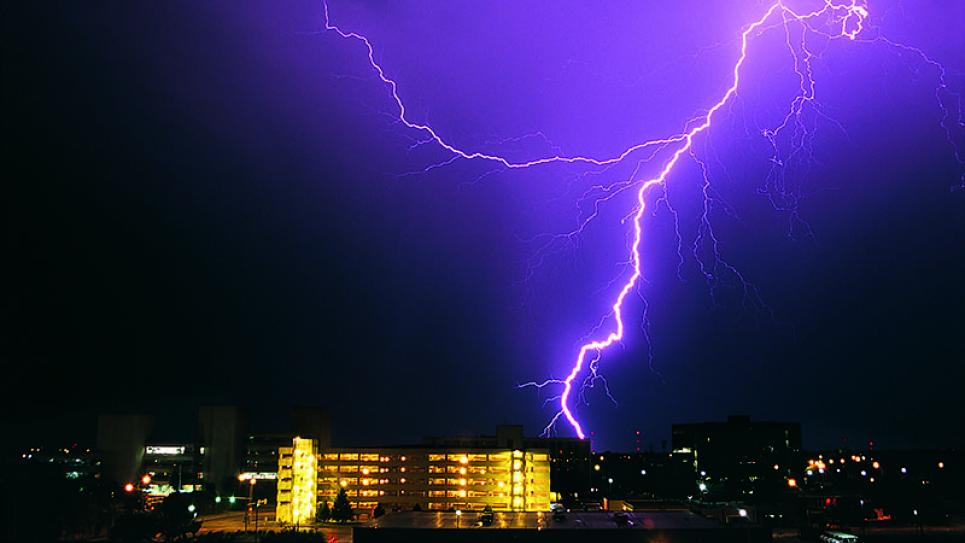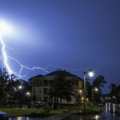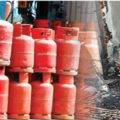Lightning is a discharge of electricity. A single stroke of lightning can heat the air around it to 30,000°C (54,000°F). This extreme heating causes the air to expand explosively fast. The expansion creates a shock wave that turns into a booming sound wave, known as thunder.
Lightning detection systems in the United States monitor an average of 25 million strokes of lightning from clouds to ground during some 100,000 thunderstorms every year. The odds of becoming a lightning victim in the U.S. in any one year is 1 in 700,000. The odds of being struck in your lifetime is 1 in 3,000. About 240,000 incidents regarding lightning strikes happen globally each year. According to National Geographic, annually about 2,000 people are killed worldwide by lightning.
What’s Happening Within the Cloud?
As ice crystals high within a thunderstorm cloud flow up and down in the turbulent air, they crash into each other. Small negatively charged particles called electrons are knocked off some ice and added to other ice as they crash past each other. This separates the positive (+) and negative (-) charges of the cloud. The top of the cloud becomes positively charged while the base of the cloud becomes negatively charged.
How is a Lightning Bolt Formed?
Because opposites attract, the negative charge at the bottom of the storm cloud wants to link up with the ground’s positive charge. Once the negative charge at the bottom of the cloud gets large enough, a flow of negative charge called a stepped leader rushes toward the Earth. The positive charges at the ground are attracted to the stepped leader, so positive charge flows upward from the ground. When the stepped leader and the positive charge meet, a strong electric current carries positive charge up into the cloud. This electric current is known as the return stroke. We see it as the bright flash of a lightning bolt.
Thunder and lightning occur at roughly the same time although you see the flash of lightning before you hear the thunder. This is because light travels much faster than sound.
What Attracts Lightning To A House?
A house or other substantial building offers the best protection from lightning. For a shelter to provide protection from lightning, it must contain a mechanism for conducting the electrical current from the point of contact to the ground. These mechanisms may be on the outside of the structure, may be contained within the walls of the structure, or may be a combination of the two.
On the outside, lightning can travel along the outer shell of the building or may follow metal gutters and downspouts to the ground. Inside a structure, lightning can follow conductors such as the electrical wiring, plumbing, and telephone lines to the ground. Unless specifically designed to be lightning safe, small structures do little, if anything, to protect occupants from lightning. Many small open shelters on athletic fields, on golf courses, in parks, at roadside picnic areas, in school yards, and elsewhere are designed to protect people from rain and sun, but not lightning.
A shelter that does not contain plumbing or wiring throughout or some other mechanism for grounding from the roof to ground is not safe. Small wooden, vinyl, or metal sheds offer little or no protection from lightning and should be avoided during thunderstorms.
How Lightning Enters Homes and Buildings
There are three main ways lightning enters homes and buildings: a direct strike, through wires or pipes that extend outside the structure and into the ground. Regardless of the method of entrance, once in a structure, the lightning can travel through the electrical, phone, plumbing, and radio or television reception systems. Lightning can also travel through any metal wires or bars in concrete walls or flooring.
- Phone use is the leading cause of indoor lightning injuries in the United States. Lightning can travel long distances in both phone and electrical wires, particularly in rural areas.
- Do not lie on the concrete floor of a garage as it likely contains a wire mesh. In general, basements are a safe place to go during thunderstorms. However, avoid contact with concrete walls, which may contain metal reinforcing bars.
- Avoid washers and dryers, since they not only have contacts with the plumbing and electrical systems but also contain an electrical path to the outside through the dryer vent.
- Avoid contact with electrical equipment or cords. If you plan to unplug any electronic equipment, do so well before the storm arrives.
- Avoid contact with plumbing. Do not wash your hands, do not take a shower, do not wash dishes, and do not do laundry.
- Victims of lightning do not retain the charge and are not “electrified.” It is safe to help them.
- Rubber shoes will not give you any meaningful protection from lightning.
- Lightning can—and often does—strike in the same place twice. Tall buildings and monuments are frequently hit by lightning.
- A motor car with a metal top can offer you some protection—but keep your hands from the metal sides.
- An umbrella can increase your chances of being struck by lightning if it makes you the tallest object in the area.
- Always avoid being the highest object anywhere—or taking shelter near or under the highest object, including tall trees. Avoid being near a lightning rod or standing near metal objects such as a fence or underground pipes.
During a thunderstorm, it’s best to take shelter in a house, other structure or a hard-topped, fully enclosed vehicle. But as one of these options may not be available to you, your safety and wellbeing may depend on knowing the difference between these lightning myths and the facts.
Myths and Facts About Lightning
Myth #1 – Lightning never strikes twice in the same place.
Fact: Lightning often strikes the same place repeatedly, especially if it’s a tall, pointy, isolated object. The Empire State Building was once used as a lightning laboratory because it is hit nearly 25 times per year, and has been known to have been hit up to a dozen times during a single storm.
Myth #2 – Lightning only strikes the tallest objects.
Fact: Lightning is indiscriminate and it can find you anywhere. Lightning may hit the ground instead of a tree, cars instead of nearby telephone poles, and parking lots instead of buildings.
Myth #3 – If you’re stuck in a thunderstorm, being under a tree is better than no shelter at all.
Fact: Sheltering under a tree is just about the worst thing you can do. If lightning does hit the tree, there’s the chance that a “ground charge” will spread out from the tree in all directions. Being underneath a tree is the second leading cause of lightning casualties.
Myth #4 – If you don’t see rain or clouds, you’re safe.
Fact: Lightning often strikes more than three miles from the thunderstorm, far outside the rain or even the thunderstorm cloud. Though infrequent, “bolts from the blue” have been known to strike areas as distant as 10 miles from their thunderstorm origins, where the skies appear clear.
Myth #5 – A car’s rubber tires will protect you from lightning
Fact: True, being in a car will likely protect you. But most vehicles are actually safe because the metal roof and sides divert lightning around you—the rubber tires have little to do with keeping you safe. Convertibles, motorcycles, bikes, open shelled outdoor recreation vehicles and cars with plastic or fiberglass shells offer no lightning protection at all.
Myth #6 – If you’re outside in a storm, lie flat on the ground.
Fact: Lying flat on the ground makes you more vulnerable to electrocution, not less. Lightning generates potentially deadly electrical currents along the ground in all directions—by lying down, you’re providing more potential points on your body to hit.
Myth #7 – If you touch a lightning victim, you’ll be electrocuted.
Fact: The human body doesn’t store electricity. It is perfectly safe to touch a lightning victim to give them first aid.
Myth #8 – Wearing metal on your body attracts lightning.
Fact: The presence of metal makes very little difference in determining where lightning will strike. Height, pointy shape and isolation are the dominant factors in whether lightning will strike an object (including you). However, touching or being near metal objects, such as a fence, can be unsafe when thunderstorms are nearby. If lightning does happen to hit one area of the fence—even a long distance away—the metal can conduct the electricity and electrocute you.
Myth #9 – A house will always keep you safe from lightning.
Fact: While a house is the safest place you can be during a storm, just going inside isn’t enough. You must avoid any conducting path leading outside, such as electrical appliances, wires, TV cables, plumbing, metal doors or metal window frames. Don’t stand near a window to watch the lightning. An inside room is generally safe, but a home equipped with a professionally installed lightning protection system is the safest shelter available.
Myth #10 – Surge suppressors can protect a home against lightning.
Fact: Surge arresters and suppressors are important components of a complete lightning protection system, but can do nothing to protect a structure against a direct lightning strike. These items must be installed in conjunction with a lightning protection system to provide whole house protection.





